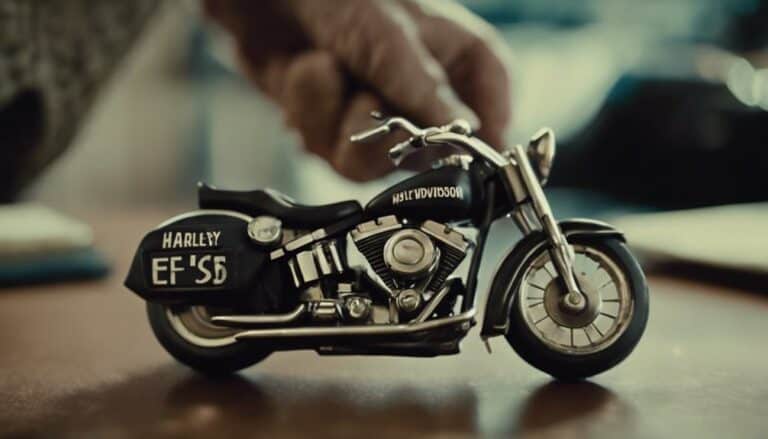Imagine walking into a Harley Davidson dealership, eyeing that sleek bike you’ve been dreaming about.
But have you ever wondered what the dealer pays for that motorcycle? Understanding the dealer cost can give you valuable insights into the negotiation process and help you secure a better deal.
Let’s unravel the mystery behind Harley Davidson dealer pricing and how it shapes your purchasing experience.
Key Takeaways
- Dealer cost influenced by various factors, typically around 25% markup.
- Understanding dealer cost crucial for negotiating fair deals.
- Dealer incentives and discounts impact final motorcycle cost.
- Awareness of invoice price aids in negotiating dealer markup effectively.
Factors Affecting Dealer Cost
Dealers’ cost for Harley-Davidson motorcycles is influenced by various factors that impact their profit margins and pricing strategies. When purchasing new Harley-Davidson motorcycles, dealers often pay less than what customers pay. The estimated markup percentage for dealers typically hovers around 25%, allowing room for negotiation when buying a bike. Understanding the dealer cost is important for effective negotiation, as it directly affects the final selling price. By comprehending the factors that contribute to dealer pricing dynamics, such as the initial cost of the motorcycle and the associated expenses, buyers can navigate the negotiation process more adeptly.
The negotiation between buyers and dealers plays a significant role in determining the ultimate price of a Harley-Davidson motorcycle. Dealers aim to strike a balance between maximizing their profit margins and remaining competitive in the market. Being aware of the dealer’s cost structure and the markup percentage enables buyers to make informed decisions during the purchase process. Ultimately, understanding these factors empowers buyers to secure a fair deal while ensuring dealers maintain their profitability.
Understanding Invoice Price
Understanding the invoice price of Harley-Davidson motorcycles is important for buyers looking to negotiate a fair deal with dealers. When delving into the details of dealer invoice price, keep these points in mind:
- Dealer Invoice Price: This is the amount that dealers pay to the manufacturer for the Harley-Davidson motorcycles they purchase.
- Customer Price Discrepancy: Typically, the dealer invoice price is lower than the price offered to customers, allowing room for negotiations.
- Additional Costs: It’s important to note that the invoice price doesn’t include extra expenses like dealer fees, taxes, or shipping charges.
Negotiating Dealer Markup
To secure a favorable deal on a Harley-Davidson motorcycle purchase, it’s imperative to navigate negotiations surrounding the dealer markup percentage. When considering a model like the Road Glide® Special, understanding that dealers typically pay less than the customer price for Harley-Davidson motorcycles becomes essential.
The estimated markup percentage of around 25% leaves room for negotiation, impacting the final selling price. Dealers strategically set the selling price to maximize their profit margins on each sale, but being aware of this allows customers to negotiate effectively.
Dealer Incentives and Discounts
Dealer incentives and discounts play an important role in influencing the final cost of Harley-Davidson motorcycles for customers. Understanding these aspects can help you make informed decisions and potentially save money on your purchase. Here are some key points to take into account:
- Volume Discounts: Dealers may receive discounts from the manufacturer based on the volume of Harley-Davidson motorcycles they sell. These volume discounts can enable dealers to lower their overall costs, which could translate to savings for you as a buyer.
- Rebates: Manufacturers sometimes offer rebates to dealers as incentives to promote sales. Dealers can pass on these rebates to customers, reducing the final price of the motorcycle.
- Special Programs: Harley-Davidson may run special programs that provide additional discounts to dealers under certain conditions. Being aware of these programs can help you negotiate a better deal on models like the Road King.
Tips for Getting the Best Deal
For the best deal on a Harley-Davidson motorcycle, consider leveraging your negotiation skills to potentially lower the final selling price. Dealers pay less than the customer price, with a markup percentage of around 25%. Understanding dealer pricing dynamics and invoice costs can give you an advantage in negotiations.
Research market trends and dealer pricing strategies to arm yourself with valuable information. By shopping around and comparing prices, you can guarantee you’re getting the most competitive offer. Dealers aim to maximize profits, so being informed about dealer costs can help you secure a better deal.
Utilize online resources like Fora platforms, including forums and purchase through links, to gather insights and tips from experienced buyers. Keep an eye out for Black Trim specials or promotions that can further enhance your savings.
Conclusion
Next time you’re in the market for a Harley-Davidson motorcycle, remember that dealers typically mark up the price by around 25%.
For example, if a bike is listed at $25,000, the dealer likely pays around $20,000, making a profit of approximately $5,000.
Understanding how dealer cost and markup work, negotiating effectively, and leveraging dealer incentives can help you get the best possible deal on your dream bike.
Ride on!


A 25% mark up is different than dealer cost of 75% of MSRP.
With a customer price of $25k, a 25% mark up shows the dealer paying $20k and making $5k
With a customer price of $25k and the dealer paying 75%, dealer cost is $18,750 with a $6,250 profit.
You’re absolutely right! Thanks for pointing that out. I appreciate the clarification – the math does indeed show different outcomes. I’ll update the article to reflect the correct calculations. Thanks for reading and for your sharp eye!